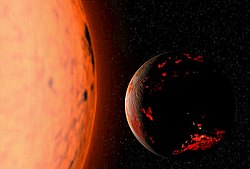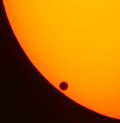The stability of the Solar System is a subject of much inquiry in astronomy. Though the planets have historically been stable as observed, and will be...
26 KB (3,101 words) - 01:29, 26 May 2025
is evidence that the formation of the Solar System began about 4.6 billion years ago with the gravitational collapse of a small part of a giant molecular...
113 KB (13,512 words) - 23:15, 21 May 2025
Jacques Laskar (category Members of the French Academy of Sciences)
system and relating it to the study of climate on geological time scales Celestial mechanics Chaos theory Milankovitch cycles Stability of the Solar System...
5 KB (504 words) - 10:05, 8 May 2025
The Solar System is the gravitationally bound system of the Sun and the objects that orbit it. It formed about 4.6 billion years ago when a dense region...
224 KB (21,986 words) - 04:36, 29 May 2025
Pierre-Simon Laplace (redirect from Analytical Theory of Probabilities)
vital to the development of the theory, are not sufficiently precise to demonstrate the stability of the Solar System; today the Solar System is understood...
107 KB (13,313 words) - 14:54, 23 May 2025
Chronology of the universe Far future in fiction Far future in religion Eschatology Formation and evolution of the Solar System Stability of the Solar System List...
180 KB (7,960 words) - 08:57, 31 May 2025
model of the Solar System is a set of mathematical equations, which, when solved, give the approximate positions of the planets as a function of time....
11 KB (1,876 words) - 22:53, 1 April 2025
surface, the cooling rate of the planet's interior, gravitational interactions with other objects in the Solar System, and a steady increase in the Sun's...
99 KB (11,034 words) - 23:18, 25 May 2025
Lyapunov time (category Dynamical systems)
mechanics where it is important for the problem of the stability of the Solar System. However, empirical estimation of the Lyapunov time is often associated...
3 KB (269 words) - 22:16, 26 April 2024
perovskite solar cells was improved with a new kind of "molecular glue". As of 2021, the existing stability tests for solar panels and solar cell systems are...
200 KB (22,835 words) - 01:39, 23 May 2025
Star (section Units of measurement)
S2CID 119347770. Szebehely, Victor G.; Curran, Richard B. (1985). Stability of the Solar System and Its Minor Natural and Artificial Bodies. Springer. ISBN 978-90-277-2046-7...
147 KB (16,423 words) - 20:22, 31 May 2025
Konstantin Batygin (category Russian emigrants to the United States)
"The Dynamical Stability of the Solar System". Batygin subsequently obtained a Ph.D. degree in Planetary Science in 2012 from California Institute of Technology...
9 KB (750 words) - 14:23, 1 January 2025
Horvath. By the end of the century analytical treatments were rigorous enough to verify the stability of the Solar System solely on the basis of Newton's...
124 KB (14,819 words) - 04:13, 29 May 2025
gravitation, the stability of the Solar System, tides, the precession of the equinoxes, the libration of the Moon, and Saturn's rings in publishing the fifth and...
10 KB (921 words) - 22:44, 26 May 2025
Earth's orbit (redirect from Orbit of the Earth)
(584 million mi). Ignoring the influence of other Solar System bodies, Earth's orbit, also called Earth's revolution, is an ellipse with the Earth–Sun barycenter...
17 KB (1,860 words) - 12:44, 24 March 2025
be specified. Since the discovery of Newton's law of universal gravitation in the 17th century, the stability of the Solar System has preoccupied many...
98 KB (10,356 words) - 06:43, 21 May 2025
Brownlee (1824). The French scholar Pierre-Simon Laplace, in essays (1810 and 1814) on the stability of the Solar System, wrote that "the weight of evidence for...
23 KB (2,144 words) - 12:41, 23 May 2025
Deferent and epicycle (section The number of epicycles)
planetary motion. The deferent/epicycle models worked as well as they did because of the extraordinary orbital stability of the solar system. Either theory...
36 KB (4,673 words) - 13:30, 21 May 2025
The following is a timeline of Solar System astronomy and science. It includes the advances in the knowledge of the Earth at planetary scale, as part...
128 KB (13,395 words) - 05:52, 23 May 2025
Acta Mathematica (category Royal Swedish Academy of Sciences)
mathematical work concerning the stability of the Solar System by purporting to prove the stability of a special case of the three-body problem. This episode...
5 KB (434 words) - 19:12, 3 April 2025
Demetrios Eginitis (category Academic staff of the National and Kapodistrian University of Athens)
the Sorbonne from 1886 to 1890. While in France he wrote his world-renowned paper Sur la Stabilité du Système Solaire (On the Stability of the Solar System)...
22 KB (2,035 words) - 19:28, 2 November 2024
Kolmogorov–Arnold–Moser theorem (category Theorems in dynamical systems)
Stability of the Solar System Arnold diffusion Ergodic theory Hofstadter's butterfly Nekhoroshev estimates A. N. Kolmogorov, "On the Conservation of Conditionally...
10 KB (1,243 words) - 22:56, 27 September 2024
Planet Nine (redirect from Solar Planet Nine)
ninth planet in the outer region of the Solar System. Its gravitational effects could explain the peculiar clustering of orbits for a group of extreme trans-Neptunian...
184 KB (19,718 words) - 00:31, 31 May 2025
Orrery (redirect from Planetary machines, an historical account of)
mechanical model of the Solar System that illustrates or predicts the relative positions and motions of the planets and moons, usually according to the heliocentric...
29 KB (3,090 words) - 00:32, 27 May 2025
Brouwer fixed-point theorem (category Theory of continuous functions)
are now known. At the end of the 19th century, the old problem of the stability of the solar system returned into the focus of the mathematical community...
61 KB (8,516 words) - 04:02, 21 May 2025
Perturbation (astronomy) (category Dynamics of the Solar System)
elements Stability of the Solar System Footnotes Newton (1684) wrote: "By reason of the deviation of the Sun from the center of gravity, the centripetal...
21 KB (2,425 words) - 08:15, 1 April 2025
Urbain Le Verrier (category Recipients of the Gold Medal of the Royal Astronomical Society)
the Secular Variations of the Orbits of the Planets). This work addressed the then most-important question in astronomy: the stability of the Solar System...
20 KB (2,088 words) - 05:06, 30 May 2025
N-body problem (redirect from Many particle systems)
model of the Solar System Stability of the Solar System Few-body systems N-body simulation, a method for numerically obtaining trajectories of bodies...
67 KB (8,738 words) - 19:30, 27 May 2025
Extreme trans-Neptunian object (category Solar System)
orbiting the Sun well beyond Neptune (30 AU) in the outermost region of the Solar System. An ETNO has a large semi-major axis of at least 150–250 AU. The orbits...
30 KB (2,325 words) - 16:08, 24 May 2025
Oscar II (redirect from Oscar II of Norway)
potential areas of research, one of which was the n-body problem in celestial mechanics, relevant to the stability of the Solar System. Henri Poincare...
41 KB (3,431 words) - 09:30, 30 March 2025





















